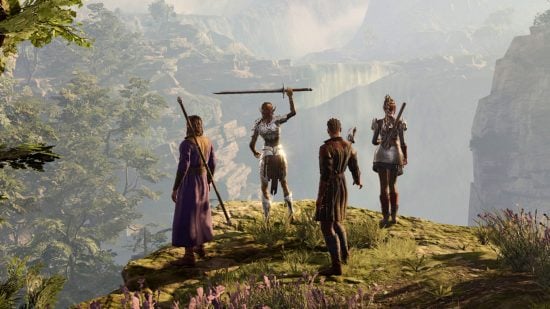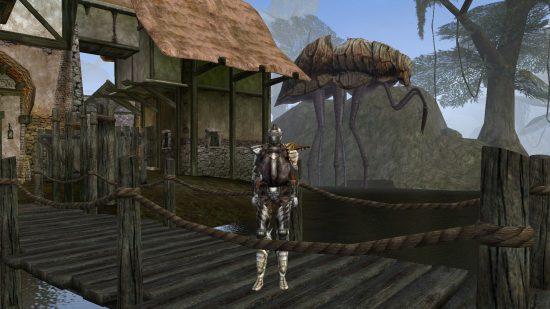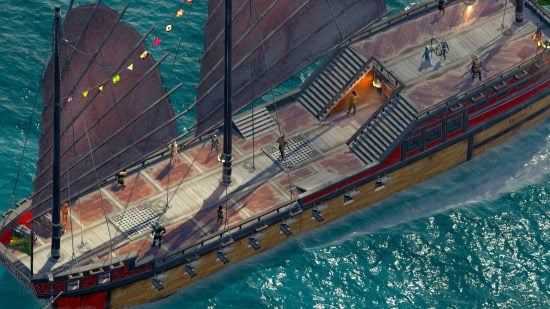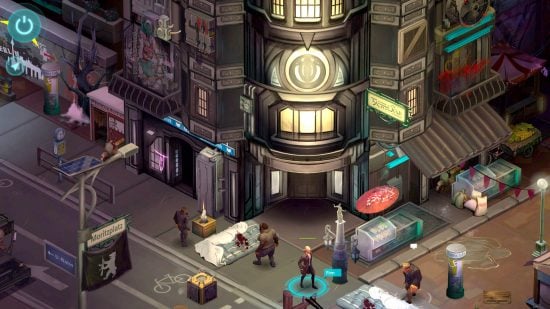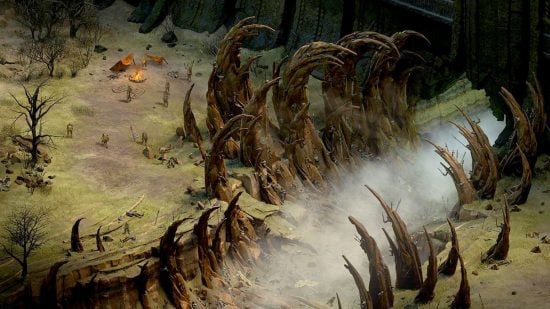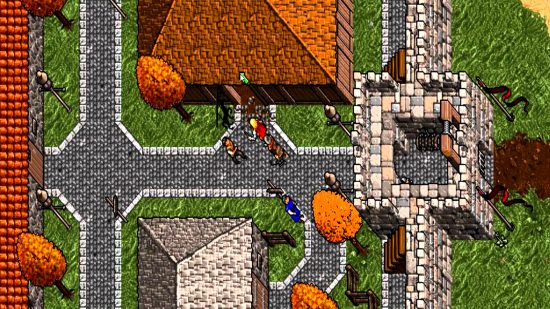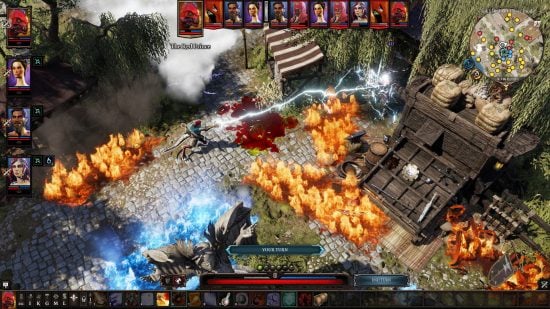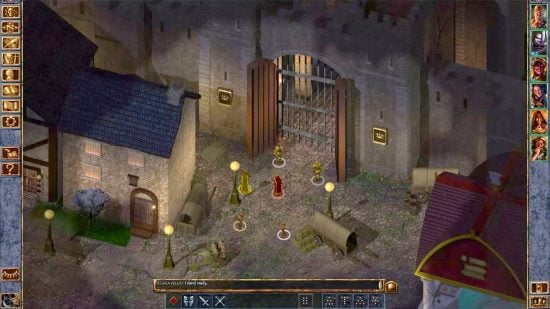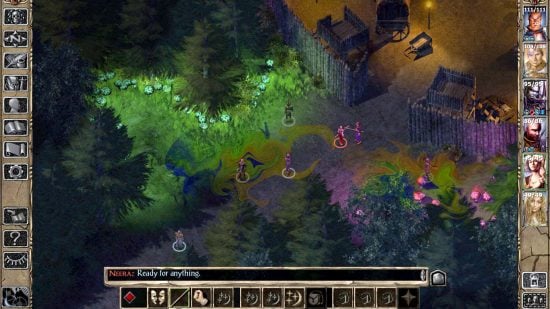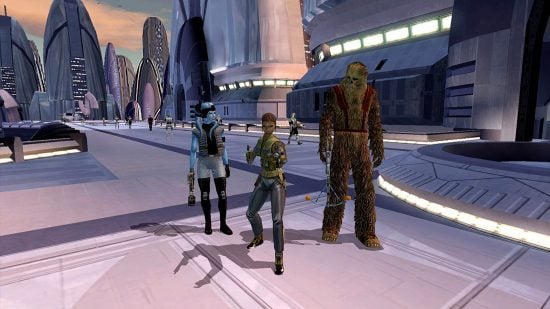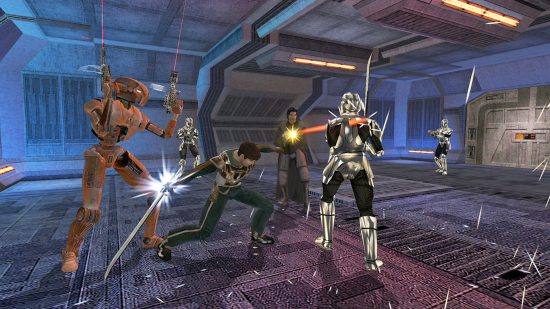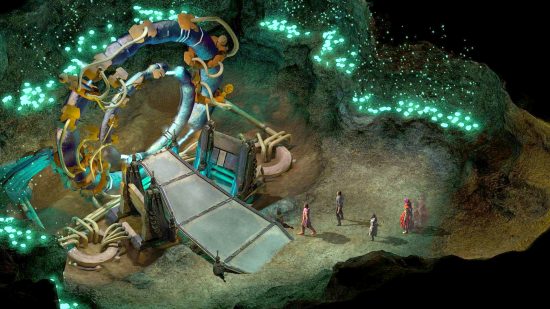The best CRPGs are uniquely immersive games set in rich worlds, where you can truly become someone else. When our pale blue marble gets too much, it can be a relief to retreat to Tamriel, Britannia, the Forgotten Realms, or even a nuclear wasteland, and live a life reality simply can’t provide. From our preposterously extensive testing, these are the best CRPGs 2023 has to offer.
Just like Dungeons and Dragons and the other classic tabletop RPGs (and, to a lesser extent, miniature wargames) that inspired them, CPRGs have blossomed in recent years. No longer a ‘museum’ genre of superb but forgotten relics, modern gaming has embraced the CRPG, leading to some absolute masterpieces being released.
Since 2012, a parade of games like XCOM has transformed turn based games in general from an unfashionable tabletop sideshow into a very nearly AAA genre – and the DnD game triumph that is Baldur’s Gate 3 has all but made it official.
The best CRPGs in 2023 are:
- Baldur’s Gate 3
- Planescape: Torment: Enhanced Edition
- The Elder Scrolls II: Daggerfall
- The Elder Scrolls III: Morrowind
- Disco Elysium: The Final Cut
- Arcanum: Of Steamworks And Magick Obscura
- Pillars of Eternity
- Pillars of Eternity II: Deadfire
- Dark Sun: Wake of the Ravager
- Shadowrun: Dragonfall
- Tyranny
- Wasteland 3
- Ultima IV: Quest of the Avatar
- Ultima VII: The Complete Edition
- Divinity: Original Sin 2
- Darklands
- Baldur’s Gate: Enhanced Edition
- Baldur’s Gate II: Shadows of Amn: Enhanced Edition
- Fallout: A Post Nuclear Role Playing Game
- Fallout 2: A Post Nuclear Role Playing Game
- Star Wars Knights of the Old Republic
- Star Wars Knights of the Old Republic 2: The Sith Lords
- Torment: Tides of Numenera
The explicit CRPG meaning might be up for debate, but one thing isn’t: CRPGs are back in style, baby – and ripe for a new golden age! So come with us as we take a look at the best CRPGs you can play in 2023, all the way from 90s classics to today’s cutting edge titles.
Baldur’s Gate 3
Let’s start with one of the biggest games of 2023. Baldur’s Gate 3, developed by veteran CRPG creator Larian Studios, is a masterclass on how to take the CRPG formula and bring it bang up to date. If you’re even slightly interested in the genre, this is a game that should be permanently installed on your hard drive (and in your heart).
Don’t believe us? Check out our Baldur’s Gate 3 review, where we named it the best DnD game ever made. Probably the closest you’ll ever get to a tabletop DnD session on computer, Baldur’s Gate 3 is simply the pinnacle of the CRPG genre, and one of those rare games that truly earns every single breathless, grovelling plaudit it receives.
Planescape: Torment: Enhanced Edition
You awake in a mortuary, your only companion a chattering skull, your only clue to your identity a carved scrawl covering your back.
That’s the compelling set-up to Planescape: Torment, and the game never lets up from there. Combining classic CRPG design, brilliant characters, and some of the best writing ever seen in a video game, Planescape: Torment is one of those games to truly savour. As you explore the non-Euclidean city of Sigil, you’ll learn who you are, who your companions are, and what your choices really mean in a world born of a truly fevered imagination.
With an Enhanced Edition now available, the wonderful art and backdrops found in Planescape: Torment can be fully appreciated for the first time.
There’s a reason this game gets mentioned every time a list like this is created – it really is one of the best RPGs you will ever encounter and you owe it to yourself to play it.
The Elder Scrolls II: Daggerfall
If you like your games big – and we mean really, really big – then the second game in Bethesda’s painfully famous Elder Scrolls series is calling to you from beyond the grave.
The Elder Scrolls II: Daggerfall’s biggest strength is its bewildering breadth; the total area you can explore is roughly the same as the entire landmass of the United Kingdom, filled with thousands of towns, dungeons, villages, and even a few daemonic witch covens.
This breadth extends to the options you can explore with your character. Character creation has rarely been so full of choices as in Daggerfall. Become a barbarian, become an archer, become a spell-slinging battlemage, become a black-clad assassin. It’s all possible, and these choices will determine how you approach the entire game.
Just don’t invest too much in language skills. Trust us on this.
The Elder Scrolls III: Morrowind
Daggerfall may be broad, but The Elder Scrolls III: Morrowind – the first truly modern, 3D entry in the series – is small but perfectly formed. Hitting that sweet spot between the latter Elder Scrolls’ games RPG-light action adventure approach and the earlier entries’ dense, stat-laden RPG barrage, Morrowind is renowned as a classic for good reason.
In addition to being heavily influenced by tabletop RPGs, Morrowind’s world and exploration of meaty ideas are the main draws. Its setting of the volcanic island of Vvardenfell is unlike anything else in gaming, populated with weird creatures that look to have wandered out of a Roger Dean painting.
It’s also a very adult game in the true sense of that word. It asks questions, but is wary of providing the answers, letting you explore big dilemmas in your own time. It could be argued (and frequently is) that Morrowind was the last time Bethesda did this well in any of its games – but we’ll leave it up to you to decide.
Disco Elysium – The Final Cut
Speaking of adult; here’s Disco Elysium. Set in a sad, worn-out world where you play as a sad, worn-out detective, Disco Elysium boasts a narrative and freedom of decision making that’s unparalleled in gaming.
How people react to you and how you solve problems are all determined by who you are. You determine this by your choices, but also by slotting ideas and concepts into your limited head-space.
Play as a fascist, play as a communist, play as a centrist – the game gives you the tools to explore a character style and then takes the hands off the reins, showing you the consequences of your actions through other people and the options available to you.
You’re in charge here and no matter what you choose, you’ll experience a surprising narrative and one of the best CRPGs to ever be created. For more info, read our sister site PCGamesN’s full 9/10 Disco Elysium review.
Arcanum: Of Steamworks And Magick Obscura
The first game from Troika Games, founded by ex-Black Isle developers, Arcanum: Of Steamworks and Magick Obscura is a riot of imagination. Set in a world where magic and technology battle each other in myriad ways, Arcanum is a game much in the same vein as the earlier Fallouts but with its own unique twists on the formula.
Key to its success is the tension between magic, expressed through races such as Elves and spellcasting, and technology which Dwarves have embraced and much of the world has now become reliant on. Lean too much in one direction and you’ll find using its opposite harder or even impossible.
Magic users may be unable to take trains, while gunslinging tech-heads may get no benefit from magic potions or spells. It brings a depth and life to the setting, and makes Arcanum: Of Steamworks and Magick Obscura a joy to immerse yourself in.
Pillars of Eternity
Baldur’s Gate 3 may have revolutionised the CRPG genre but there’s plenty of space for games that simply evolve it. Enter Pillars of Eternity, from Fallout: New Vegas developers Obsidian. Crowdfunded to a colossal degree, Pillars of Eternity is a callback to the days of the original Baldur’s Gate, albeit with many of the rough edges sanded off.
Set in a delightfully grim area known as the Dyrwood, your character is a newcomer to the region. Quickly afflicted by an ability that lets you see the past souls of a person along with threatening to steal your sanity, you become immersed in the area’s factions, plots, and the dark curse that underpins it all. Grittier than its forebears but no less delightful, Pillars of Eternity has earned its status as a modern classic.
For a deeper read, you should check out our sister site PCGamesN’s 10/10 Pillars of Eternity review.
Pillars of Eternity II: Deadfire
Pillars of Eternity II: Deadfire, the sequel, sees you pick up the story of your character from the first game, but now you’ve headed to sunnier climes. The Deadfire Archipelago is your new home, and with it, Pillars isn’t just lighter in color palette, its tone’s lightened up too.
This time around you’re heading to the seas with your own crew and ship, chasing down a colossal green god who’s causing a whole boatload of trouble.
Refining the classic Baldur’s Gate CRPG formula even further, Pillars of Eternity II: Deadfire is a breath of fresh air that still manages to explore some heavy metaphysical questions.
Deadfire garnered a shining 9/10 score from our pals at PCGamesN – you can read their Pillars of Eternity 2 Deadfire review for more.
Dark Sun: Wake of the Ravager
The impression that many might have of Dungeons and Dragons settings is that they’re all, well, dungeons and dragons. Elves and swords. Treasure and goblins. DnD games like Dark Sun: Wake of the Ravager, however, show that Dungeons and Dragons is, at its core, weird as heck.
In a desert land your team of hardy adventurers take on the mysterious Dragon and the Lord Warrior, joining a plucky band of rebels as you try to bring justice to the city of Tyr.
If that wasn’t enough, Wake of the Ravager is filled with all the odder things in the bestiary of DnD monsters, from Mind Flayers to Yuan-ti and everything in-between. If you think you’ve seen everything Dungeons and Dragons has to offer, Dark Sun: Wake of the Ravager shows that there’s plenty more to experience out there.
Shadowrun: Dragonfall
The return of Shadowrun to the CRPG scene in 2013 saw three games emerge from developers Harebrained Schemes. For our money the second of these, Shadowrun: Dragonfall, is the best of the three.
Shadowrun’s world is a cyberpunk fantasy where elves and orcs rub shoulders with hackers and AI-controlled drones. In Shadowrun: Dragonfall the player picks up the action in the anarchic free state of Berlin, joining a mercenary team and uncovering secrets long-hidden from the citizens of Europe.
Where Shadowrun: Dragonfall really excels is in its treatment of its characters. Each of your team members is a fully-realised person, with their own backstory and mission to explore. Even the dog gets a moment in the spotlight. And it’s a very, very good dog indeed.
Tyranny
Playing as a baddie in a video game can be troublesome. Who among us has never loaded up Mass Effect, fixed on attempting a Renegade run, only to make the same Paragon decisions as always?
Tyranny, from CRPG master Obsidian Entertainment, helps put that dilemma to rest by setting itself in a world where the baddies have already won, with you playing as one of their top lieutenants.
As is traditional with CRPGs, you still have a lot of freedom in how you approach your adventure, who you choose as allies, and how your story plays out. By placing the player within the pocket of evil, however, it gives experienced quest-completers a fresh twist on the genre.
For a full rundown of the evil options, read the Tyranny review by our siblings at PCGamesN.
Wasteland 3
The return of Wasteland in 2014’s Wasteland 2 was a triumph, taking the game series that inspired the more-famous Fallout and showing everyone why it’s still important today. Wasteland 3, released in 2020, made that even clearer. It proves there’s definitely space for more than one take on the post-apocalyptic role playing game sub-genre.
Wasteland 3 relocates the player to Colorado – snowy, mountainous Colorado – which is a big departure from the desert-like Arizona and California of the first two games.
Like in the previous Wastelands, you and a gaggle of Desert Rangers are here to save the day, but you’ll have to navigate a bunch of competing factions with differing ideologies if you want to do it.
Like its predecessors, Wasteland 3 is a turn-based, squad-based CRPG that lets you tell your own story in a world trying to build itself anew. It’s a rollicking ride that earned 9/10 in our sister site PCGamesN’s Wasteland 3 review – it’s worth diving into that if you want more detail.
Ultima IV: Quest of the Avatar
The Ultima series is probably the most impactful game series you’ve never played. Directly inspiring both the Dragon Quest and Final Fantasy series, these games are responsible for a huge swathe of RPGs.
The first three games in the series each have their innovations but it’s Ultima IV: Quest of the Avatar that really shook up the CRPG world. The player finds themselves transported to the peaceful land of Britannia where there’s no big bad to defeat, no overwhelming threat to fight.
Instead, the player must prove their worth against eight virtues such as Honesty, Compassion, Humility, and Justice. Once the player has proved their understanding of the virtues, overcome a dungeon, and found a few artefacts they are proclaimed the Avatar.
Unlike most games, even today, Ultima IV is notable because it’s a true open world adventure that judges you on your actions constantly. You are to uphold an ideal, not win a fight. This was amazing in 1985 and remains so even today.
Thankfully a DOSBox version and various upgrade patches exist to allow players to get their hands on this ancient game and experience it on modern systems.
Ultima VII: The Complete Edition
If Ultima IV showed the world how CRPGs could have a remarkable focus, Ultima VII showed us how games could simulate a living, breathing world.
The seventh game in the series gives the player an entire world to explore, with unprecedented amounts of interactivity. Want some bread? Why not cut down some wheat, take it to the mill, turn it into flour, mix it with water, and bake it. Cannons can be fired, plays can be taken part in, banks can be robbed. It’s a huge world…and that’s only part one.
In Ultima VII: The Complete Edition you get both parts of the Ultima VII story, The Black Gate and Serpent Isle (and their expansions). The Black Gate sees the Avatar return to Britannia, hunting down a cultish conspiracy with colossal ramifications. In Serpent Isle, the Avatar follows a lead to a land not seen in the series since the pre-Ultima IV days, where new mysteries, threats, and strange magics await.
The first part is a true open world, the second is a more linear adventure but no less compelling for it. With source ports such as Exult existing, there’s no reason not to try out the definitive Ultima VII experience.
Divinity: Original Sin 2
Larian has a long history making CRPGs and has spent a long time honing its craft. In Divinity: Original Sin 2, it hit upon gold. Set in the studio’s (very) long-running Divinity setting, Divinity: Original Sin 2 is a mostly-unrelated follow-up to the, er, original Original Sin, that improves upon it in every way – and then some.
If you haven’t played Divinity: Original Sin 2 before, we recommend starting with one of the pre-made ‘Origin’ characters, as their backstories are interwoven with the wider game, becoming essential to the storyline as they play against those of your party. All are good, and some contain some excellent storytelling that’s not to be missed in repeat playthroughs.
With precise turn-based combat where each decision matters and some truly brilliant story-telling, Divinity: Original Sin 2 is the reason so many of us were happy to see Larian Studios get their hands on the Baldur’s Gate licence.
For more on the game that made us all Larian lovers, read the full Divinity: Original Sin 2 review over at PCGamesN.
Darklands
The 1990s were an interesting time for video games. Advances in technology delivered better graphics, bigger worlds, and more compelling gameplay, but the medium was still ripe for experimentation. Hence, a lot of games tried genuinely new things – sometimes the result was shocking rubbish; other times it was pure genius.
Darklands is one of the latter examples. Set in an incredibly historically accurate recreation of medieval Europe (albeit with supernatural elements), Darklands is a non-linear open world CRPG where everything is up to you. While there is a main questline to follow which will end the game, the player is largely free to determine their own destiny.
With a truly granular approach to its role-playing simulation, Darklands is one of those games that can be appreciated time and time again. For example, if the player chooses to make their character older at the start of the game, they will start with better experience and items than a younger character.
The flipside of this is their physical skills will degrade over the course of the game, as age’s impact is simulated. If you’ve ever wanted to make every decision matter, Darklands might be the ideal game for you.
Baldur’s Gate: Enhanced Edition
For many, Baldur’s Gate was their initiation to the world of Dungeons and Dragons. Set on the Sword Coast, it features a semi-open world with a modified version of the Advanced Dungeons & Dragons 2nd edition ruleset at its core. To play, you’ll need to learn DnD stats and rules in one of the most complex forms they’ve ever taken – but trust us, it’s worth it.
On the surface, Baldur’s Gate is a simple story – there’s a bad man, go put a sword in him. From there, however, the story spirals into conspiracy, dark gods, and leads you to examine your destiny.
Noted at the time for making Dungeons and Dragons accessible yet still retaining the feel of the tabletop RPG, Baldur’s Gate is still a very ‘crunchy’ PC RPG that might be a steep learning curve for new players, at least compared to some of the newer titles on this list.
Nevertheless, it’s rightly considered an utter classic – and, with the recent Enhanced Edition, it’s never been easier to play.
Baldur’s Gate II: Shadows of Amn: Enhanced Edition
Baldur’s Gate II: Shadows of Amn picks up some time after the end of the first game, following the same character – though now captured and in dire straits. This second game spreads its wings a little further than the first one, dipping its toes into some of the metaphysical aspects of the Forgotten Realms settings.
However, it’s the focus on the party that really sets Baldur’s Gate II apart. In the previous game, the party added flavour and fighting prowess but past an introduction there might not be too much to them (apart from Minsc and Boo, of course).
In the second game, the party’s personality matters much more, with full conversations and quests to explore with your rag-tag band of adventurers. If you’ve played Dragon Age: Origins or Mass Effect, you’ll be right at home, as BioWare’s trademark ability to make you care about your team is present even here, back in 2000.
Also the main antagonist is voiced by the incomparable David Warner, so if that isn’t worth a look, we don’t know what is.
Fallout: A Post Nuclear Role Playing Game
The game that started a juggernaut, the original Fallout remains a brilliant roleplaying experience even today. Years after the fall of nuclear bombs and the end of the old world, you emerge from your vault to locate a replacement water chip to help your underground society recycle their limited water supply.
When you set foot in the wasteland you encounter more than you expected. Raiders, settlements, fledgling society trying to rebuild itself, enclaves of advanced technology, and hideous super mutants. Fallout is tightly controlled at the start but lets you slip the reins after a while, giving you a true open world adventure as you explore a landscape that’s both familiar and alien.
It’s also worth mentioning that the original Fallout has one of the best endings found in any videogame, ever.
Fallout 2: A Post Nuclear Role Playing Game
If there’s a word to sum up the leap from Fallout to Fallout 2, it’s ‘more’. Fallout 2 has more companions, more open world to explore, more story, more locations, more weapons, more combat, more enemies, more wacky elements, more easter eggs, more…more.
Fallout 2 takes you on a quest to find the Garden of Eden Creation Kit, or GECK, to save your village and terraform the surrounding area. Like the first game, the player encounters much out in the larger world that they didn’t expect to find – because what makes the Fallout universe so compelling is that it isn’t static.
Time has moved on in-between games, and the world is starting to stand on its own two feet again. Forget your Mad Maxes and even the latter Fallouts, this entry in the series shows that there might possibly be hope at the end of the tunnel. At least, for some.
Star Wars Knights of the Old Republic
Star Wars has had a chequered history when it comes to video games and when the word ‘prequel’ is mentioned, you could be forgiven for sighing out loud. So when BioWare announced they were making a CRPG set thousands of years before the original Star Wars trilogy, we didn’t know what to expect.
Thankfully, Star Wars Knights of the Old Republic is not only BioWare’s best game, it’s one of the best Star Wars games ever made. Filled with memorable characters and deepening the setting considerably, it’s a high point for the franchise as well as for CRPGs.
Showing that you can combine high budget gaming with thoughtful systems and a full roleplaying experience, Knights of the Old Republic is rightly considered one of the greatest CRPGs ever.
It also features one of the most breathtaking twists in gaming, but we won’t say any more here.
Star Wars Knights of the Old Republic 2: The Sith Lords
For Knights of the Old Republic 2, development was handed over to Obsidian Entertainment who would later go on to create Fallout: New Vegas and the Pillars of Eternity series.
What emerged was a meditative game that wasn’t afraid to ask questions that hadn’t been considered in the rest of the franchise. This is a game that looks at what it means to be Jedi or Sith, that asks what ‘good’ the Force actually achieves, and asks players to really consider the impact of their actions.
Unfortunately, Star Wars Knights of the Old Republic II had a famously rushed development period, leaving the ending feeling rushed and the conclusions unsatisfying. Thankfully, fan patches do exist which restore the planned content, so the game can be finally experienced in a near-complete version.
Torment: Tides of Numenera
If there is a criticism of Planescape: Torment, it’s that it relies on the legacy of games like Baldur’s Gate a little too heavily, making combat an integral part of the game, despite its unique strengths lying elsewhere. Torment: Tides of Numenera is an attempt to redress that criticism, with Planescape: Torment-like choices and decision making, but with the ability to either avoid or embrace combat, depending on your preference.
Set millions of years in the future where innumerable civilisations have risen and fallen, where fantastic objects from forgotten eras can be found everywhere, with no clue to their true use or meaning on the world. Torment: Tides of Numenera allows the player to shape their character, first in creation, and then constantly throughout the game, via their interactions with the inhabitants of this far-flung time.
Torment: Tides of Numenera may not be as assured as the earlier Planescape: Torment, but it wears its legacy well, and the writing found within its depths is well worth sinking one’s teeth into.
To get a better idea of the flavors on offer, read PCGamesN’s painless, 9/10 Torment Tides of Numenera review.
CRPG meaning
So, what actually is a CRPG anyway? Computer Role Playing Games are videogames which offer players a large degree of freedom to define their role in a setting. Most often, this term refers to games using a Western design philosophy, as opposed to JRPGs which stem from role playing games created in Japan.
The key aspects of CRPGs focus on player choice, decision making, a sense of place, and branching narratives. Players in a CRPG will usually create their own character, defining them through choices about who they would like to portray in the world.
This approach to decision making is usually interwoven throughout, with certain options being locked off to players depending on prior choices. The goal is to make the player feel like they are inhabiting a role, playing as their character and making decisions that reflect that character, much as they would in a tabletop RPG.
Here’s RPG-loving Youtuber CohhCarnage’s valiant attempt to define the genre:

CRPGs also tend to be less action-focused than many RPGs, though combat is often a key aspect of gameplay. The goal is often to give players tools with which to approach decisions or encounters, allowing them to express their role through play.
Finally, as you can see from most of the games in this guide, the CRPG genre is usually associated with a partial top-down, or ‘two-and-a-half dimensions’ camera viewpoint, also referred to as ‘isometric’ graphics.
However, that’s generally agreed to be less an essential defining characteristic, and more an incidental tradition resulting from many of these games feeling the need to show more of the player’s environment and surrounding characters on screen, as well as allowing more screen space for complex tactical controls. A game doesn’t have to be isometric to be considered a CRPG, and we’ll gladly die on that hill.
And that’s all we have (for now) on the phenomenally rewarding world of CRPGs – a genre of computer games that has, arguably more than any other, translated the functionally infinite, imagination-driven escapism of tabletop roleplaying to the screen.
If you’re a fan of this genre and you’ve not yet tried Baldur’s Gate 3, you owe it to yourself to do so right now – our complete guides to Baldur’s Gate 3 classes and Baldur’s Gate 3 skills, or even the best Baldur’s Gate 3 builds, should help you get started.
Alternatively, we’ll always heartily encourage a return to the tabletop – for starters, you could try our favorite solo tabletop RPGs, the best DnD one shots, or the best dungeon crawler board games. If all else fails, we can point you to the absolute best board games of all time.

